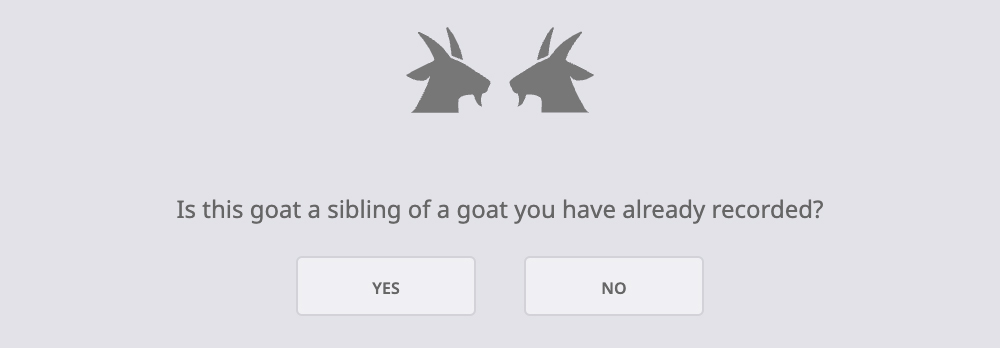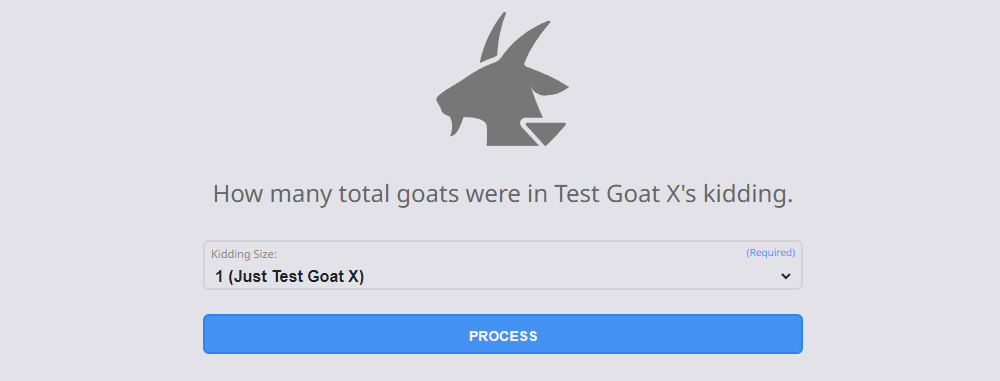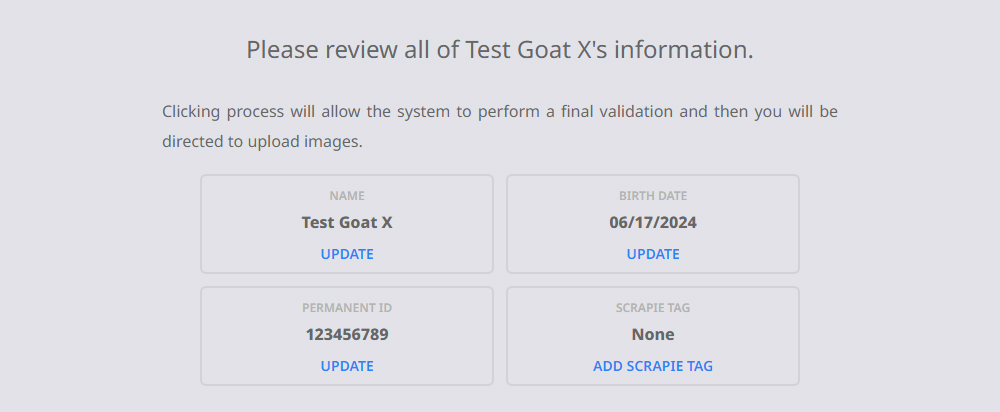A Guide on How ToRecord A Goat
Recording a new goat using the ANGBA website is a simple process that should take less than 10 minutes provided you have all of the required information. Information that you will need before you begin the process includes basic information about the goat (eye color, fiber color, etc.), lineage information (sire, dam, breeder, etc.), and a selection of current images (face/front, side, and back).
NOTE The goat recording system is not currently designed to save information as it is entered. Additionally, in order to preserve the integrity of the record, information cannot be added by the user after the recording process has completed
STEP 1: Identifying Previously Recorded Siblings

Selecting a sibling allows you to bypass several steps in the registration process. Most notably, the lineage of this goat can be imported from the sibling you select.
Selecting 'YES'
- Select the sibling from the drop down menu.
- Click process to be directed to Step 3.
Selecting 'NO'
- Questions asking you to identify the sire, dam, and breeder will be added to the recording process.
- You will be directed to Step 2.
STEP 2: Identifying the Breeder

This question asks you to identify the individual for overseeing the selection and pairing of the sire and dam that produced the offspring you are recording. As such, the breeder may be different from the owner. The system assumes that the person recording the goat is the owner
Selecting 'YES'
- The system will apply your information to the goat being recorded.
- You will be directed to Step 3.
Selecting 'NO'
The system will need to determine the breeder's information. You will be asked if the breeder is an ANGBA member.
If the breeder is an ANGBA member
- You will need to enter their ANGBA issued ID number in the provided box.
- Click process to be directed to Step 3.
If the breeder is not an ANGBA member
- You will need to provide as much of their identifying information as possible
- Click process to be directed to Step 3.
STEP 3: Permanent ID

All goats recorded with the ANGBA must have a permanent ID in the form of a microchip, tattoo, or ear tags. Goats without a permanent ID can not be recorded with the ANGBA. Please conform to all local, state, and federal laws regarding the application of permanent identification numbers to the goats in your herd.
Selecting Microchip
Microchipping is the preferred method of assigning a permanent ID to the goats in your herd.
- Enter the full number associated with the microchip inserted into the goat.
- Click process to be directed to Step 4.
Selecting Tattoo
- Enter the value tattooed on the right ear.
- Enter the value tattooed on the left ear.
- Click process to be directed to Step 4.
Selecting Ear Tags
Ear tags are the least preferred method of assigning a permanent ID to the goats in your herd.
- Enter the value of the ear tag on the right ear.
- Enter the value of the ear tag on the left ear.
- Click process to be directed to Step 4.
STEP 4: Scrapie Ear Tag

Scrapie is a fatal, degenerative disease that affects the central nervous system of sheep and goats. The Scrapie National Eradication Program (NSEP) is a cooperative state-federal-industry program working to eradicate scrapie from the United States. If your goat has NSEP ear tags, you can enter that information here.
Selecting 'YES'
- Enter the Flock Number associated with the NSEP tag.
- Enter the Animal Number associated with the NSEP tag.
- Click process to be directed to Step 5.
Selecting 'NO'
- An NSEP number will not be recorded for your goat.
- You will be directed to Step 5.
STEP 5: Entering the Goat's Name

While goats in the ANGBA database are primarily identified by their ANGBA issued ID number, goat names are easier for members to quickly identify goats.
Some things to remember when naming your goat:
- Do not include farm name or farm initials in the name of the goat. Doing so will create delays in processing by the recorder. The farm initials will be automatically added to the name during processing based on the breeder of the goat.
- Goat names can not exceed 64 characters in length. Realistically, goat names should not exceed 15 characters including spaces.
- Goat names should not contain any special characters. Only hyphens (-) and apostrophes (') are allowed.
STEP 6: Entering the Goat's Birthday

The date of your goat's birth should be as close to accurate as possible (preferably within a day). The system uses this information in calculating when the goat will be eligible for permanent review.
Some things to remember when indicating the day your goat was born:
- The date on which the goat was born can only exist in the past or the present. The system will not allow you to process dates in the future.
- How each browser handles date inputs is different. In most cases you can type the date, or select the date from the date picker.
STEP 7: Indicating the Goat's Gender

Your goat's gender is used extensively by the system in matchmaking and as a sire/dam for future generations.
Some things to remember when indicating your goat's gender:
- You can only make a single selection. A goat cannot be both a buck and a wether.
- The gender should be accurate at the time of recording. You can request a records update if a buck is wethered.
- Indicating your goat is a wether does not call past offspring into question. Indicating that the goat has been wethered only removes it from consideration in the website's planning feature.
STEP 8: Indicating the Presence of Horns

Indicating the presence, absence, or removal of horns on your goat is for identification and data tracking only. This data will be used only to improve the predictive capabilities of the website regarding the planning of offspring.
Some things to remember when indicating the presence of horns on your goat:
- You can only make a single selection. A goat cannot be both horned and not horned.
- The presence of horns or not should be accurate at the time of recording. You can request a records update if the horns are removed.
STEP 9: Indicating the Goat's Eye Color

Indicating the goat's eye color is for identification and data tracking only. This data will be used only to improve the predictive capabilities of the website regarding the planning of offspring.
Some things to remember when indicating the eye color of your goat:
- The system is not able to indicate the presence of Heterochromia. Heterochromia is a condition in which the eyes appear to be two different colors. Goat's displaying heterochromia should be recorded as 'Unknown' and a special note should be sent to the recorder.
- The eye color of the goat should be accurate at the time of recording. You can request a records update if the eye color changes.
STEP 10: Indicating the Goat's Base Coloring

Base color should not be confused with fiber color (which may be different). Base color is the color of the goat's summer coat.
Selecting 'YES'
- Selecting YES indicates to the system that you will be identifying the two most prevalent colors in your goat's base coat.
- Selecting YES will take you through the color selection process Step 11 twice.
- You will be directed to Step 11.
Selecting 'NO'
- Selecting NO indicates to the system that you will be identifying only one base coat color.
- You will be directed to Step 11.
STEP 11: Indicating the Goat's Base Coat Color

Indicating the goat's boat coat color is primarily for identification and data tracking. This data will be used only to improve the predictive capabilities of the website regarding the planning of offspring.
Some things to remember when indicating the base coat color of your goat:
- Pay attention to the prompt. If you indicated in the previous question that your goat was more than on color, you will be asked to identify both the most prevalent color and the second most prevalent color.
- Do your best. The system presents you with eight different color choices. Please select the color you feel best matches the color of your goat. This value will be reviewed and updated by the recorder based on the images you submit during the final step.
- The base coat color of the goat should be accurate at the time of recording. You can request a records update if the base coat color changes.
At this point, the system will direct you to Step 12 only if you selected YES in Step 10. If you selected NO then the system will direct you to Step 13 unless you indicated that this goat was a sibling of a previously recorded goat in Step 1 in which case you will be directed to Step 15.
STEP 12: Indicating basic pattern information

The presence of multiple base coat colors suggest that your goat may have a pattern to their coat. This question will help the recorder determine if the coloring is suggestive of a pattern (i.e. buckskin) or simply represents identifying markings (i.e. freckles).
Selecting 'YES'
- Selecting YES indicates to the system that the pattern of your goats base coat color is most likely solid with identifying markings.
- You will be directed to the next step.
Selecting 'NO'
- Selecting NO indicates to the system that the pattern is most likely a named pattern.
- The recorder will determine the pattern of your goat based on the pictures you provide in the final step.
- You will be directed to the next step.
At this point, the system will direct you to Step 15 only if you indicated that this goat was a sibling of a previously recorded goat in Step 1. Otherwise, you will be directed to Step 13.
STEP 13: Identifying a Sire and a Dam

These questions are designed to guide you through the process of identifying the sire and then the dam that produced the offspring you are recording. Because the steps for identifying the sire and the dam are the same, they are presented together in this list. Please pay attention to the prompts to ensure that you are recording the correct parent. The first question in this sequence asks if the parent was recorded with the ANGBA.
Selecting 'YES'
The system will inquire as to wether you currently own the parent goat.
If you currently own the parent goat
- The system will present you with a drop down menu of all the goats currently in your herd based on the gender of the parent you are selecting.
- The system will then ask you to identify the Dam or direct you on to Step 14.
If you do not currently own the parent goat
- The system will resent you with a box to enter the parent goat's ANGBA issued identification number.
- The system will then ask you to identify the Dam or direct you on to Step 14.
Selecting 'NO'
You will need to enter as much information as you have about the parent goat using the form entries provided.
- Name: The full name of the parent goat including any identifying farm information.
- Genetics: The genetic percentage of Nigerian Dwarf, Angora and Other. These values should be entered if they are known as they will help the system calculate the genetic makeup of the goat you are recording.
- Organization ID: The parent goat's registration or recording information in any other organization.
i|The system will then ask you to identify the Dam or direct you on to Step 14.
STEP 14: Indicating the Size of the Kidding

Indicating the size of the kidding is for data tracking only. This data will be used only to improve the predictive capabilities of the website regarding the planning of offspring.
- Use the dropdown menu to select how many goats were born with the goat you are recording.
- Click process to be directed to Step 15.
STEP 15: Information Verification

Please use this overview of the information you have entered related to your goat to review your submission for accuracy. You can revisit any value simply by clicking update on the data point you wish to revisit. Provided the information is accurate you may click PROCESS to be directed to the final step in this process.
STEP 16: Uploading Photos

The final step in the recording process consists of uploading images of the goat. All images must be less than 2MB and should be cropped prior to upload.
- Click and Add: If you click to the box associated with the image you would like to add. This will prompt your system to show a dialog box in which you can select the image you wish to upload. Mobile users will use this method.
- Drag and Drop: Locate the image and drag it into the appropriate box before dropping it.
Final Steps and The Pending Goat
After the photos of the goat you will be directed to a page explaining how you can make payment to receive your certificate. Also at this stage, the goat will appear in Your Herd and listed as 'Pending'. Goats marked as 'Pending' are being reviewed and evaluated by the recorder who will update any unrecorded/incomplete information (i.e. patterns and identifying markings). When the the recorder's review is complete, and the recorder deems the goat acceptable by the Breed Standards of the ANGBA, the goat will be moved to temporary status.
